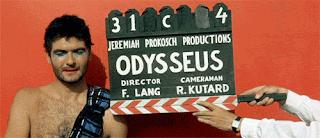 |
| Scenes within scenes in Jean-Luc Godard's Le Mépris |
It became a multi-layered life video, with the threads intersecting and leaving the trace of a certain je ne sais quoi. I personally love the cigarette draw and kiss that unexpectedly occurs in the foreground. It evokes the tight rope between art / life / camera while also capturing a quintessential French stereotype, which is well-earned and born from a period of remarkable French innovations in film during the 1960s with the Nouvelle Vague. The cigarette & kiss is classic, representing a tradition that the French New Wave film forever encapsulated and rendered un peu trop chic.
 (On a side note, I remember being oddly sad for the French when the law was passed to ban cigarette smoking on their café and restaurant terrasses in the early 2000s--I didn't think they would ever be able to resist. Anecdotally, when they passed the law that Parisiens needed to pick up the crottes left behind by their dogs--and thus everywhere on the streets--this was not abided by. It has been speculated that this is certainly because the policemen thought it much too beneath them to issue a ticket for dog poop. It was not enforced--thus the advent of the motocrotte, which is a perfect blend of the word for motocyclette and crotte and had the feature of a long vacuum.)
(On a side note, I remember being oddly sad for the French when the law was passed to ban cigarette smoking on their café and restaurant terrasses in the early 2000s--I didn't think they would ever be able to resist. Anecdotally, when they passed the law that Parisiens needed to pick up the crottes left behind by their dogs--and thus everywhere on the streets--this was not abided by. It has been speculated that this is certainly because the policemen thought it much too beneath them to issue a ticket for dog poop. It was not enforced--thus the advent of the motocrotte, which is a perfect blend of the word for motocyclette and crotte and had the feature of a long vacuum.) Even though cigarettes are disgusting (in my opinion), it is somehow gratifying to see that the French did not entirely shake the image of chic nicotine drags coupled with amorous arousal, long after the huge letters FUMER TUE appeared on the cigarette pack--as witnessed by the orality of attachment in a modern puff that ended with a young kiss in the art video above (which should be noted: is wrapped in the French flag,) the very transfer of semi-addiction! O to be young and Parisienne! I digress...
 |
The coloring of the antiquated in
Le Mépris
|
French New Wave films helped weave the inhale of the cigarette into trendy passion as it took filming to the streets in the '60s with natural lighting, unknown actors, jump cuts, and other expressionist breakthroughs --totally innovative for the time. Ultimately, the French New Wave turned established cinematic fabrication on its head. The rift between the old and the new is characterized by the mockery Godard makes of the cinema business in the film, this mockery being incarnated with the character of the American filmmaker who comes to meet the Parisian filmmaker at Cinecittà in Rome in Le Mépris (Contempt). He fits the American stereotype quite well. The film is an amazing mise-en-abyme, with the tricolore (blue, white, and red) shared by the flags of the two countries appearing throughout the film. Par exemple:
 |
| The film being made within the film is an adaptation of the story of Odysseus and Penelope |
Trailer: Le Mépris (Contempt), by Jean-Luc Godard
Filmed in Rome and Capri, Italy
(La cinématographie est sublime)
(La cinématographie est sublime)
 |
| Masculin Féminin (1966), Jean-Luc Godard |










No comments:
Post a Comment